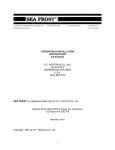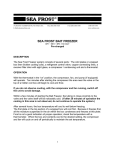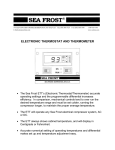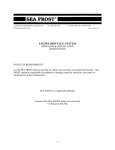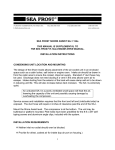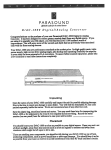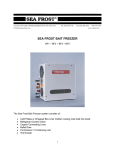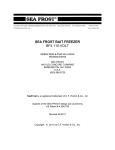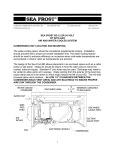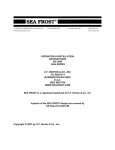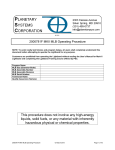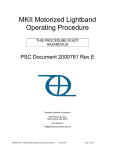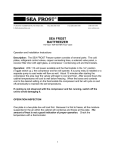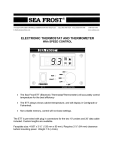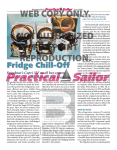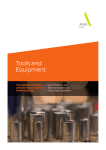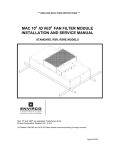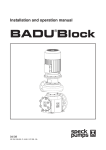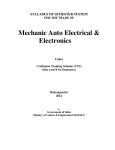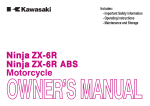Download Sea Frost DC 5000 User's Manual
Transcript
372 ROUTE 4 BARRINGTON, NH 03825 USA TEL (603) 868-5720 FAX (603) 868-1040 E-Mail:[email protected] 1-800-435-6708 www.seafrost.com DC 5000 SYSTEM 134a OPERATION & INSTALLATION INSTRUCTIONS NOTICE OF RESPONSIBILITY It is the SEA FROST/C.F. Horton & Co., Inc. intent to provide the safest, most accurate and detailed instructions. SEA FROST/C.F. Horton & Co.,Inc. cannot be responsible for problems or damage caused by omissions, inaccuracy or interpretation of these instructions. SEA FROST is a registered trademark of C.F. Horton & Co.,Inc Aspects of the SEA FROST design are covered by US Patent #4,356,708 2nd Edition 134 12 volt Copyright © 1996 by C.F. Horton & Co., Inc. 1 START UP PROCEDURE AND PERIODIC INSPECTION ATTENTION new SEA FROST owner or operator! PLEASE DO NOT OPERATE THE REFRIGERATION SYSTEM UNTIL YOU READ THIS. WARNING! Your SEA FROST System can be severely damaged and your warranty will be invalid if these steps are not followed closely. Please read the information here before proceeding to operate your system for the first time. BREAK-IN PERIOD. LIMIT COMPRESSOR RUNNING TIMES TO THIRTY MINUTES FOR THE FIRST TWO HOURS OF OPERATION. THIS SHOULD BE FOUR SEPARATE THIRTY-MINUTE OPERATIONS WITH A REST PERIOD OF AN HOUR OR MORE BETWEEN THEM. 1) Locate the SEA FROST Receiver/Filter/Drier (RFD). The location of this part varies from boat to boat, but it is often found in the compartment with the DC 5000, in a locker, or beneath the cabin sole. It is a blue metal can about 9 inches high and 3 inches in diameter, with brass fittings connecting it to copper tubing. If you do not locate the RFD quickly, follow the route of refrigeration copper tubing, from the DC 5000 to the icebox. Along the route you will find the RFD. The RFD has a sight glass for viewing the flow of refrigerant. 2) Check to be sure the proper sea cocks are open. 3) Start the DC 5000 by turning on the thermostat. The red indicator light should light, indicating 12-volt power is available and that the system is operating. Check the overboard discharge to be sure water is being pumped. 4) With the system running look at the sight glass in the RFD. 5) MONITOR THE SIGHT GLASS CONTINUALLY. White FOAM should appear in the sight glass indicating that refrigerant is present. This foam may disappear quite quickly, but IF NO FOAM IS EVIDENT, that is, if the sight glass does not show the presence of refrigerant within a minute or two of operation the system is dead flat. DO NOT CONTINUE TO OPERATE THE SYSTEM. OPERATION IN THIS MODE WILL RUIN THE COMPRESSOR. Switch off the DC 5000 to prevent operation until the problem is corrected. CALL US AT 603-868-5720. 6) If white foam is evident watch closely for a transition from foam to clear: a clear sight glass indicates a sufficiently charged system. This point can be missed if proper attention is not given. A FULL SIGHT GLASS AND AN EMPTY GLASS LOOK THE SAME! It is possible for the sight glass to show large, almost stationary bubbles even when the charge is sufficient, so it is important to differentiate between "foam" and larger “bubbles”. The foam condition has velocity and direction, but the larger bubbles are nearly stationary. If the foam does not clear, the system is low on charge. CALL US AT 603-868-5720 for trouble shooting and correction help. 2 There are three conditions of charge indicated by the sight glass: 1. A black or clear glass and no cooling indicates no charge. Turn off the compressor at once. 2. A white foaming glass and some cooling indicates the system is undercharged or has lost charge. Refer to the manual regarding leak checking and adding charge. 3. A black glass and proper cooling indicates all is well. RFD SIGHT GLASS DETAIL EMPTY OR CLEAR STATIONARY BUBBLES FOAM/LOW Feel the SEA FROST Plate in the icebox ten minutes after engaging the timer switch. If the sight glass clears yet the plate temperature does not drop after 10 minutes of operation, turn off the system and CALL US AT 603-868-5720. Inspecting the sight glass periodically for several weeks after a new installation and every time after a lay period is assurance that your SEA FROST DC 5000 system is assembled properly and is a good maintenance habit as well. 3 TABLE OF CONTENTS OPERATION GENERAL DESCRIPTION ICE MAKING MAINTENANCE HOW REFRIGERATION WORKS INSTALLATION COMPRESSOR INSTALLATION WATER PUMP PLATES VALVE UNIT SWAGELOK FITTINGS, MAKE-UP & RECONNECTING RECEIVER FILTER DRYER ELECTRICAL SYSTEM; WIRING; THERMOSTAT CONTROL PANEL WIRING DIAGRAM ASSEMBLY INSPECTION CHECK LIST REFRIGERANT HANDLING ACCESS TO THE SYSTEM: SERVICE PORTS GAUGES LEAK CHECKING NEW SYSTEM CHARGING READING THE SIGHT GLASS PROPER CHARGE AMOUNT: MAXIMUM CHARGE DISCHARGING THE SYSTEM TROUBLE SHOOTING PRESSURE CHARTS DC5000 MOTOR MAINTENANCE DRAWINGS VOLTAGE MONITORING RELAY WIRING 4 5 5 7 7-8 8-9 9 11 12 13 13 14-16 18-19 20 21-22 23 23-24 25 25-26 28-29 28 31 32 33 33-34 37-38 39-40 42-45 46 GENERAL DESCRIPTION The SEA FROST DC 5000 is a cold storage refrigeration system powered by a 1/2 horsepower permanent magnet direct current 12-volt motor. Refrigerant from the compressor is piped to the SEA FROST plate in the icebox. Cold storage is attained by rapidly freezing the solution contained in the plate, creating a captive (replenishable) block of ice. The system may be used when the boat’s engine is on and charging the batteries or with a properly sized battery bank. The compressor may be controlled by an oil pressure switch preventing operation without the engine, a lockout relay that prevents operation without the shore power charger operating, a timer, or by a thermostat alone. The heat removed from the icebox is discharged into the seawater at the water-cooled heat exchanger. A separate pump below the water line controlled by the DC 5000 pumps water through the heat exchanger and overboard above the water line. BREAK-IN PERIOD. REFER TO THE START UP PROCEDURE IN THE BEGINNING OF THIS MANUAL. EVERY TIME THE SYSTEM IS RESTARTED FROM WARM, CHECK TO BE SURE IT IS COOLING BEFORE OPERATING THE COMPRESSOR EXTENSIVELY. THIS IS YOUR SYSTEM. SIMPLE OBSERVATIONS OF YOUR SYSTEM AND OPERATING CAUTION WILL PREVENT DAMAGE THAT COULD COST YOU MONEY. OPERATION 1. This system is water-cooled and depends on water being pumped by the remote DC 5000 pump. The proper sea cock must be open before starting the system. Water flow is most important, therefore CHECK THE WATER FLOW AFTER STARTING THE SYSTEM. 2. Check the battery switch position and voltage readings before starting. 3. Start the DC 5000 by turning on the thermostat. The red indicator light should light, indicating 12-volt power is available and that the system is operating. Check the overboard discharge to be sure water is being pumped. 4. If the battery system is fitted with an amp/hr meter you will notice the DC 5000 compressor drawing about 45 amps/hr (12 volts) for the first few minutes dropping to 35 amps/hr for the remainder of the cycle. 5. After 10 minutes of operation, check for a drop in the cold plate temperature by feeling the plate with your hand. If no noticeable cooling has occurred, turn off the thermostat. Check the charge level (See checking the refrigerant charge section) and check the water flow. TO PROTECT THE COMPRESSOR, DO NOT OPERATE the system if this temperature drop is not noted. CALL US AT 603-868-5720. 5 After about one hour (with a single plate), the plate will become very cold. Starting from warm will require more running than the normal refreezing time of the plate in its usable temperature range. The concept of the SEA FROST system is to create as much frozen material in the plate as fast as possible. This "coldness" then keeps the cabinet cold. Daily running times are based on the time needed to freeze enough of the plate to maintain proper cooling. The plate must be frozen. Chilling the plate without freezing it will not provide any holdover. You will learn about the daily time required for SEA FROST operation by using the system. Note: Maximum holdover time will be obtained when the cabinet and contents are at their lowest temperatures and the plate is frozen solid. There is no limit to "on" time however, no advantage is gained by running the system beyond this point and in refrigeration applications over running will freeze items. Over running will also produce undue wear on the motor, compressor and pump. Cabinet size, cabinet insulation, contents added to be cooled, cabinet opening and closing, and climate effect the holdover time. SUGGESTIONS As soon as the system has stopped the plate will begin to warm up as it absorbs heat, cooling the refrigerated box. You might decide that it is a good idea to run the unit in the last minutes of the day to provide ice for drinks. Maximum storage will require that the plate be frozen. The plate may thaw (be above freezing) and still not require running in refrigeration applications. Monitor the box temperature itself not the plate temperature. For minimum battery consumption set the thermostat at the highest (warmest) possible setting. This would be toward one snowflake. When the engine or generator are operating and charging, operate the DC 5000 at the maximum (coldest) setting to increase the holdover storage and minimize battery consumption by freezing the plates solid. With timer operated systems two shorter periods a day may be better than a long one once a day. When the holdover freezing is complete the benefit of running is only to delay warming. There is some help in that cooling of the contents of the box will increase holdover time but heat, "cold", moves slowly and it will be more efficient to wait and run again later. Experimentation will provide the best instruction on how the SEA FROST DC 5000 should be operated on your boat. DEFROSTING will be required. A heavy layer of frost or ice will reduce cooling. This is very important in freezers. 6 ICE MAKING WITH VERTICAL TRAYS ON VERTICAL PLATE SYSTEMS Fill the vertical trays with water and hang them on the stainless steel rod on the face of the plate. Try to get some water between the tray and the plate surface to increase the thermal contact to speed freezing. The trays may take time to freeze after the plate is frozen and the compressor has been switched off. HARVESTING VERTICAL TRAYS Plan to wait for the trays to thaw in a sink or away from the plate in the refrigerator. When the outside surface is wet invert the tray and let the ice slide out. STORAGE OF ICE CUBES After ice has been made and harvested, store it in sealable plastic bags in the refrigerator or freezer. Leaving the ice in trays in contact with the plate will allow the ice to melt if the plate goes above freezing. MAINTENANCE Like your engine, your SEA FROST needs periodic checking. ROUTINELY CHECK: 1. The refrigerant charge. (See Start Up Procedure text) NEVER OPERATE SYSTEM WITHOUT PROPER CHARGE. 2. All components, bilge and engine room fittings for corrosion and wear. BE SURE TO LOCATE AND INSPECT ALL FITTINGS AND COMPONENTS IN THE SYSTEM. KNOW THE LOCATION OF ALL CONNECTION POINTS. Spray with a rust inhibitor REGULARLY. Corrosion unchecked in the marine environment will severely reduce the life of your system. 3. Motor maintenance. Brush wear must be checked at early intervals to determine future required inspection. Failure to inspect and replace brushes when needed will ruin your motor. See: Motor & pump maintenance, pages 3940. 4. Winter storage will require that the water pump and water-cooled condenser be drained or flushed and filled with antifreeze solution to avoid freeze damage. If the condenser is to be left dry flushing with a large amount of fresh water to remove salt deposits is recommended. (The pump will not self-prime. It might be necessary to install a hose and funnel on the intake to force-feed the pump.) 7 CLEANING The plate surface protects itself with a layer of oxidation. You might find after a long period of storage the plate will look chalky. This will not effect operation and is easily cleaned up with a pot scrubber and soap. HOW REFRIGERATION WORKS There are two important concepts to understand in order to learn about refrigeration. They are latent heat and phase changes. A great deal of heat is required to change a solid to a liquid, and a liquid to a vapor. A great deal of heat must be removed to reverse these changes. These changes are called phase changes, or changes of state. The heat removed or added at these phase changes has no effect on the temperature of the substances until the change is complete. For instance, ice melts at 32 degrees F. Water freezes at 32 degrees F. Ice and water will remain at 32 degrees F. until the freezing or melting process is complete. Latent heat is this hidden energy required to make or break the bonds in a phase change. By evaporating liquid to a vapor, we can absorb heat. By condensing a vapor to a liquid, we give up heat. Refrigeration is the use of these phase changes to move heat out of the icebox (cooling it). We all know that cold is the absence of heat. A practical example of heat absorption by evaporation is rubbing alcohol evaporates in your hand and cools it. The alcohol is actually using the heat from your hand to boil. The absorption of heat cools your hand. Pressure affects the temperature at which a vapor phase change will occur. Using water as an example, water boils at sea level at 212.F. On top of Mt. Everest it boils at a much lower temperature. The air pressure is lower allowing the water-to-steam phase change to occur more easily. A pressure cooker increases the pressure on water to restrict boiling to a higher temperature. A pressure cooker will cook food faster because the temperature is higher. Remember that a phase change involves latent heat. The temperature of boiling water is only 212.F at sea level. The evaporation action is absorbing heat at a rate equal to the rate of heat applied, preventing further temperature rise. Let's look at Refrigerant-134a. R-134a will boil at minus 15 degrees F. at sea level. By evaporating liquid R-134a in the SEA FROST plate, heat is absorbed making refrigerant vapor. To dispose of this heat, a condensing phase change is necessary. By increasing the pressure (compressing) we can raise the boiling point of the refrigerant vapor at the condenser. Seawater passing the condenser coils removes the heat, forcing the vapor to a liquid state again. Pressure, therefore, is the key that allows passing the heat we have taken from the icebox to a warmer place (the sea water) and converting the vapor to liquid to be evaporated again. 8 By causing R-134a to boil (evaporate) in the SEA FROST plate, we use the heat energy there. This activity cools the liquid solution within the plate, causing it to change phase (freezing to a solid). By freezing this solution, we have increased its heat absorption capacity more than 100 times. When the cycle is stopped (the compressor is turned off) the frozen plate will begin to absorb the heat that leaks through the insulation in the icebox. The absorption will be at a constant temperature until the phase change to liquid (melting) is complete. This is the principle of holdover refrigeration and the function of your SEA FROST. INSTALLATION ~ WORK HABITS Installer's care should be stressed. No matter how good SEA FROST equipment is, it's performance and life are in the hands of the installer. To insure your work: 1. 2. 3. 4. 5. 6. Read this manual. Reread any aspect you don't understand. Follow Swagelok fitting instructions carefully. Install the RFD last and the same day the system is charged. Spend enough time leak checking to be sure there are no leaks. Thanks from all of us who have to guarantee your work. There are two contaminants that will give you problems in a refrigeration system. They are WATER and DIRT. Moisture in the air is always present and cannot be eliminated; water in this case refers to puddles and drops. Dirt is any solid. The installer's habits will be most important in ensuring a trouble-free start-up. We have added a large receiver filter drier (RFD) to take care of all dirt and moisture that might get into the system during a careful installation. Moisture in the system is boiled off when the system is evacuated, or it is captured in the desiccant. There is a screen in the expansion valve to prevent dirt from plugging it. Excess moisture that the RFD can't handle will plug the expansion valve with ice. This ice stops the cycle. The only cure is to discharge the refrigerant, replace the RFD, evacuate the system, and recharge it. This remedy takes time and is somewhat costly. Keep the system clean and dry! TUBE HANDLING Installation is quite simple. All the copper tube comes to you with the ends capped. Any routing of the tubing must be done with the tube either taped or capped. Cap both tube ends after each cut. Work with only one line at a time, and uncap only one end at a time. 9 TUBE CUTTING Use only a tube cutter; hacksawing or any other method will introduce chips to the system and also distort the tube, making connections difficult and leak-prone. A miniature cutter is essential for this work. CUT SLOWLY to avoid a ridge on the inside of the tube. We do not recommend reaming or dressing the cut, as it is very easy to get chips of copper in the system that will cause trouble. TUBE BENDING Make all but the long sweep bends with a spring bender; one kink and the line must be rerun. Don't add any more fittings than are absolutely necessary. Route all the lines in such a way that they are most direct but out of the way. Always leave several inches of straight undistorted tubing leading to all Swagelok fittings to allow proper connection. Again, keep everything sealed until you are ready to make that connection. FIT RFD LAST The RFD (receiver, filter, drier) should be the last component to be unpacked and fitted. INSTALLING THE DC 5000 COMPRESSOR UNIT Install the DC 5000 in a dry location where the convergence of wires, water hoses and tubing to the refrigerator area are the most convenient. Avoid installing the DC 5000 on 10 a bulkhead that directly separates the living space from the machine space to avoid excessive sound radiation. The DC 5000 may be installed close to a bulkhead and overhead. Allow access to the front (as shown in the drawing above) and left end where the tubes and hoses will exit. Fasten the DC 5000 through the (4) drilled holes in the base. THE BRUSHES WILL REQUIRE PERIODIC INSPECTION AND REPLACEMENT. BE SURE THE DC 5000 IS LOCATED WHERE BOTH BRUSH COVERS CAN BE ACCESSED. WATER PUMP INSTALLATION AND WATER CIRCUIT Proper water pump installation is essential to a trouble free system. • The pump will not self-prime. • The pump must be well below the water line on all angles of heel. • The pump motor must be above the pump body. • The pump outlet must be above the pump inlet. • The pump should have it's own intake through hull with sea cock, sea strainer and exit through hull. 11 Install the intake through hull as low in the boat as possible. The minimum size through hull should be 1/2". In areas of floating weed and jelly fish a larger through hull might be beneficial. The sea strainer should be positioned above the through hull with no loops of hose that could trap air. The pump should be positioned above the strainer and pump up to the DC 5000. The water hose from the DC 5000 should leave the condenser and descend or remain parallel to the water line exiting a through hull above the water line. ABOUT THE PUMP The March 809 BR pumps are not self-priming. The coupling between the impeller and the motor is through a pair of magnets. The impeller is water lubricated and does not touch the housing in proper operation. The advantage of this pump is a long life, quiet operation and low power consumption. To treat this pump properly it must be flooded at all times. Air pockets created by rising and falling hose levels and an improperly located pump and strainer will trap air, which the pump will not be able to displace preventing water pumping. The only acceptable installation will not have air pockets in the water circuit. PLATE LOCATION The plate size, location, and plumbing are designed for each application. This information is provided with each system. SEA FROST holdover plates mount with a "Wellnut" expandable neoprene blind hole fastener. A template or the plate itself should be used to locate the mounting holes. Drill 1/4" pilot holes then increase them to 1/2". Install the screw into the mounting tab then screw the Wellnut onto the screw. Install the plate pushing the rubber mounts into the pre-drilled holes. Tighten the screws. 12 VALVE UNIT V/U For appearance and convenience of installation, the valve unit may be mounted outside the icebox. In certain applications and multiple plate systems it may be best to mount it inside. Location of the V/U in multiple plate systems is indicated in the design layout from our application engineer. On an externally mounted V/U two 1/2" Swagelok fittings fasten the V/U to tubing protruding through the icebox wall. Before cutting the tubing: • Leave a minimum of 1 1/4" of tube beyond the bulkhead. • Allow room for wrench access. On any installation: • The Valve Unit may be mounted in any position. • 90-degree elbows can be factory installed on the Valve Unit to reduce the space requirements if necessary. • The tubing will support the Valve Unit. • The tubing must bottom in the fitting. For final installation of this unit see the Swagelok text. • The V/U will attract moisture. If it is mounted externally to the cabinet be sure it is accessible for proper insulation installation after the system has been leak checked and operationally tested. NOTES ON SWAGELOK FITTINGS Swagelok fittings come to you completely assembled, finger-tight. (Pieces a, b, and c in Drawing #1 are already together). They are ready for immediate use. Disassembly before use can result in dirt and foreign material getting into the fitting and causing leaks. If disassembly is necessary, reassemble per drawing. This is a double ferrule system. The most serious installation problem encountered with SEA FROST is the incorrect assembly of these fittings. Be absolutely sure that you assemble all fittings as in Drawing #1. To ease assembly slacken the fitting nut slightly before assembly. Then tighten with fingers before tightening with a wrench. (This is to avoid cross threading.) Step 1. Always leave two inches of straight, undistorted tubing leading to all Swagelok fittings to allow proper connection. 13 Step 2. Prior to inserting 1/2" tubing into the Swagelok tube fitting, make a pencil mark 1" from end of tube. Prior to inserting 3/8" tubing, make a pencil mark 3/4" from the end of the tube. With 1/4" tubing make a mark 5/8" from the end. Step 3. Insert clean, smooth tubing with the pencil mark into the Swagelok tube fitting. You can be sure the tube is resting firmly on the shoulder of the fitting when the pencil mark is flush with the nut. This mark will also indicate that the tube has not moved before tightening. (As the fitting is tightened the space from the pencil mark to the shoulder will increase.) Step 4. Tighten the Swagelok nut to a wrench snug* position. Scribe the nut with a pencil at the 6:00 o'clock position (see drawing #1, step # 2). * Wrench snug is the first point in the assembly tightening when the tube cannot be pulled from the fitting, (i.e. when the ferrules tighten enough to contact the tubing). Step 5. Now, while holding the fitting body with a back-up wrench, tighten the nut oneand-one-quarter turns (1+1/4). To do so, watch the scribe mark, make one complete revolution, and continue to the 9:00 o'clock position. (See drawing #1, step #3). DRAWING 1 STEP 1 Simply insert the tubing into the SWAGELOK tube fitting. Make sure that the tubing rest firmly on the shoulder of the fitting and that the nut is wrench snug. 14 STEP 2 Before tightening the SWAGELOK nut, scribe the nut at the six o'clock position. STEP 3 Now, while holding the fitting body steady with a backup wrench, tighten the nut 1 1/4 turns. Watch the scribe mark, make one complete revolution and continue to the 9 o'clock position. By scribing the nut at the 6 o'clock position as it appears to you, there will be no doubt as to the starting position. When tightened 1 1/4 turns to the 9 o'clock position, you can easily see that the fitting has been properly installed. * SWAGELOK FITTINGS ARE TO BE TIGHTENED TO A TORQUE SPECIFICATION NOT INFINITE TIGHTNESS. BE SURE YOUR STARTING POINT IS WRENCH SNUG. A DISTORTED TUBE MIGHT GIVE A FALSE STARTING POINT. * When making all connections, USE TWO WRENCHES. Don't allow the fittings to turn or twist when tightening. * Be sure the fitting nut is not cross threaded! Cross threading will ruin the fitting. The fittings on the V/U cannot be replaced; as a result cross threading will ruin the V/U. RECONNECTING PRE-SWAGED FITTINGS Connections can be disconnected and re tightened many times. When reconnecting, insert the tubing with pre-swaged ferrules into the fitting until the front ferrule seats in the fitting. Tighten the nut by hand to avoid cross threading. Rotate the nut about one-quarter turn with a wrench (or to original one-and-one-quarter tight position). Then snug slightly with the wrench. 15 SWAGELOK PERFORMANCE Swagelok fittings have built-in spring interaction between the ferrules. This compensates for temperature changes, vibration loosening and allows the fittings to be reconnected many times. As the fitting is tightened, a burnishing occurs between the body of the fitting and the ferrules and between the ferrules and the tube. This action provides a leak proof connection. RUNNING THE LINES See the schematic diagram. Prior to making up connections see "Swagelok Fittings" texts. 16 PLANNING 1. Keep tube runs as short as possible. The suction (return) line should be as direct as possible with a minimum number of bends. 2. Tape the 1/4" line and the 1/2" line together in the section between the V/U and the DC 5000. This is for thermal exchange (sub cooling). POSITIONING THE RFD • The RFD is fitted with a sight glass. This glass must be visible for charging and servicing the system. It can be viewed from the top at up to a 45-degree angle but not from the bottom or side. A mirror installed above the glass is one way of saving a poorly planned installation. Avoid this if possible. Be sure the sight glass is easily visible! • Observe the inlet/outlet on RFD when mounting it. The glass is offset toward the outlet. • The RFD should be unpacked and installed only after all the lines are run and all other fittings are made. HELPFUL TOOLS • Coil spring-type tube benders are available for 3/8"-1/2" O.D. tube. These springs are slid over the tube. The bend is formed in the spring, and then the spring is removed by unscrewing. • Lever benders for each size tube. Lever benders will make the tightest possible bend without distorting the tube. • Mini tube cutter: "IMP" by Gould Imperial requires less than 1 1/2" radius clearance for the cut. This is essential to trim the plate tubes. LINE CONNECTION PLAN Run 1/4" copper tube from the DC 5000 to the RFD. From the RFD 1/4" copper tube continues to the V/U. Run 1/2" copper tube from the large connection on the V/U to the DC 5000. The two lines should be combined with tape and insulated together. See Insulating the Lines. 17 RFD (Receiver Filter Drier) DO NOT OPEN THE RFD UNTIL ALL THE OTHER CONNECTIONS HAVE BEEN MADE AND YOU ARE READY TO COMMISSION THE SYSTEM. Because the RFD contains desiccant to absorb moisture and the absorption is limited, it is important to unpack and install it after all other connections are made. Leaving the RFD installed on a partially open system may reduce its capacity by allowing it to absorb moisture in free air before the system is sealed. The RFD is a reservoir for excess refrigerant. The RFD also contains a sight glass in the top. (Please refer to the planning section regarding location and "readability" of the sight glass) A pick-up tube extends from the bottom of the canister to the outlet. For proper function of the reservoir, the RFD must be VERTICAL to ensure proper operation at various heel angles. MOUNTING THE RFD The inlet is from the DC 5000. (The sight glass is offset on the RFD toward the outlet.) The RFD is to be mounted with the bracket and mounting strap. Cable ties with screw mounts should be used to support the tubing. INSULATING THE LINES Insulating should be the last step after leak testing because it will cover fittings that must be leak-checked. On long uninterrupted lengths of tubing, the insulation can be slipped over the tube early. Insulation should be installed only on dry lines, and only after the acrylic spray is applied to all metal parts. The suction return line is cold and will attract moisture (as frost) when running. The suction return line includes all the exposed 1/2" tubing and the larger fittings. The entire V/U will also frost. It is important to insulate the 1/2" line, the V/U and all the fittings along the line to prevent moisture from gathering. INSTALL THE INSULATION IN A MANNER THAT WILL NOT TRAP WATER AROUND A LOW POINT. Trapping salty bilge water in the insulation will reduce the operating life of tubing and fittings. If the insulation is split and wrapped over the tube, install it with the split side down. Tubing within the icebox need not be insulated. 18 CABLE TIES Cable Ties should be used to support the wiring, tubing, and insulation. There is a screw hole in the end of each tie that is used for mounting. Loosely loop the tie, mount the screw loosely, snug the wrap, tighten the screw, and trim the excess. Be sure not to leave a sharp end on the cable tie. ELECTRICAL SYSTEM The electrical system for the DC 5000 system includes a Thermostat Control Panel with pilot light, and a junction box with solenoid. 19 THERMOSTAT CONTROL PANEL LOCATION The Thermostat Control Panel should be outside the box in order to protect it and to allow observation of the indicator lamp. The length of the sensing tube dictates the location, as it must reach the plate. The maximum length of this tube is 40" (180 mm.) (The sensing tube must be attached to the refrigerator plate in a multiple plate system.) Mount the Thermostat in a location where the wires and sensing tube can be led. Use the cut out template packed with the Thermostat Control Panel. The harness on the Thermostat Control Panel may be spliced with 16-gauge wire. ELECTRICAL JUNCTION BOX The DC 5000 is equipped with a 4' (105 cm.) harness that is to connect to the Electrical Junction Box. Do not splice this harness. Position the Electrical Junction Box to allow proper routing of the harness. If the electrical junction box is closer than 4 feet, shorten the harness. Large battery supply cables, (See wire sizes) the thermostat control harness, and water pump harness will all connect at the electrical junction box. 20 WIRE SIZES This information is to be used as a guide only. Please make sure your wiring meets or exceeds all applicable standards. The DC 5000 must be wired with heavy gauge wire from the batteries to the Electrical Junction Box in order to supply the proper current and voltage. Follow the chart below based on the ABYC specifications allowing a 10% voltage drop. If possible use the next larger size. These distances are from the batteries to the Electrical Junction Box. 10 gauge less than 10 feet 8 gauge less than 15 feet At a minimum use: 6 gauge less than 25 feet 4 gauge less than 40 feet 21 The positive and negative cable total length must not exceed twice the distance listed above. Be sure your wire length calculation is from the batteries not the connection points of the supply wires. (It is assumed that heavier cable is used to supply an electrical junction like the battery switch or buss bar.) FUSES Fuse the 12-volt positive wire from the battery to the Electrical Junction Box with a 50amp fuse. The fuse location should be as close as possible to the battery or selector switch. (Refer to ABYC standards) If a breaker is used it must be rated for 75 amps @ 12 volts. WIRING The best installation should have the shortest possible conductor lengths connecting the batteries and the Electrical Junction Box. Do not feed the DC 5000 from the boats 12-volt breaker panel. Voltage drop and power loss can occur through the supply wires, terminal ends, and switching devices. An in line fuse can act as a service disconnect. Wires should be kept out of the bilge and wet areas. Secure wires every 18 " with nylon tie-wraps or non metallic clamps. GROUND WIRE Connect the ground lug to the engine negative boat ground with a green 8-gauge wire. ASSEMBLY INSPECTION CHECK LIST [ ] 1. Check accessibility of brush covers for service. [ ] 2. Check that the RFD sight glass can be seen. [ ] 3. Check all the Swagelok connections with wrenches to be sure they have been made up. Refresh your knowledge by rereading the Swagelok instructions. 22 [ ] 4. Check all the hose clamps for tightness. [ ] 5. Check the neatness of the installation, sufficient service access, secure wiring, and make sure tubing and hoses are supported to prevent damage and chafing. [ ] 6. Check the service access. The service access ports must allow attachment of the connecting service valves. [ ] 7. Check (after leak checking and testing) that the tubing is properly insulated. REFRIGERANT HANDLING AND SAFETY Do not proceed if you do not fully understand the procedure and know what results to expect. Understand that pressure exists in refrigeration systems. Be careful. DISCLAIMER The gauges, adapters, hoses and tools described in this manual are available from Sea Frost. We are not familiar with all equipment and cannot be sure we are covering procedures that can be preformed without the same equipment. Be certain you understand what you are doing and how each valve, check valve, can tap, adapter, and gauge set works before connecting to a charged system or a refrigerant supply. REFRIGERANT The SEA FROST DC 5000 is charged with REFRIGERANT 134a. R-134a is a chemical compound called tetrafloroethane. It is odorless. Its boiling point is -15. degrees F. at sea level. It is heavier than air. It's label and container color is light blue. R-134a is used in auto air conditioning systems and should be available in auto parts stores. GENERAL SAFETY THIS IS IMPORTANT. READ THIS! R-134a is safe if handled properly. Avoid breathing vapors and prolonged skin exposure. Avoid using in areas of open flames. The vapor is heavier than air and may reduce oxygen available for breathing. Use with sufficient ventilation to keep exposure below recommended limits. Do not mix with air for leak testing or use with air for any purpose above atmospheric pressure. Liquid R-134a will freeze skin. It's especially dangerous to the irreparable tissues of the eyes. --WEAR EYE PROTECTION-Do not pressurize an empty system with R-134a without first evacuating the system with a vacuum pump. 23 WARNING NEVER OPERATE a system WITH THE HIGH side (discharge) OPEN TO the REFRIGERANT supply. Pressurization of the refrigerant container could cause it to burst. WARNING. When charging or working on the system installed in an engine room with the engine running, watch for MOVING BELTS AND PULLEYS. Loose clothes and long hair can pull you into a belt. PLEASE BE CAREFUL. PROCEDURES FOR WORKING WITH R-134a 1) A new uncharged system must be evacuated before adding R-134a. 2) An R-134a system must only be pressurized with R-134a or nitrogen. 3) Only service tools dedicated to R-134a are to be used. No parts, tubing, fittings, receivers, driers, service gauges, or any refrigerant carrying components may be fitted to a R-134a system from a used system or from a CFC based system. Damage caused by the use of parts not supplied by Sea Frost for a R-134a system will cancel all claims against Sea Frost. 4) No oil is to be added to the DC 5000 system but the PAG oil supplied by Sea Frost, labeled and capped for DC 5000 use. No oil is to be added to a system with out prior consultation with Sea Frost. 5) The oils used in R-134a systems are extremely moisture sensitive (hydroscopic). Do not leave any tube end or component connection open to air while assembling the system. Be sure to use only new-capped copper tubing and be sure to cap the copper coil after cutting it. ACCESS TO THE SYSTEM: SERVICE ACCESS PORTS The access ports are two small capped valves mounted on the tubing on the top of the DC 5000. The ports are of different sizes. The large fitting is the discharge port and is connected to the 3/8" diameter tube. The smaller fitting is the suction port and is connected to the 1/2" diameter tube. These ports are the service access to the system. To access these ports the proper connecting valve must be used. (See Gauges) Be sure the plastic port caps are installed tightly after charging or service. The caps are to seal the ports. Without the caps the ports may leak. 24 GAUGES Gauges must be used in the evacuation and charging. They will provide information on the operation of the system when troubleshooting. A gauge sets consist of two gauges installed in a manifold with two hand wheel valves and hoses to connect the gauges to the system. The left gauge (blue) is a compound device; it indicates pressure and also vacuum. The right gauge (red) indicates pressure only. The hand wheels open a center port (yellow) to the left or right side respectively. Operation of the hand wheels is only necessary when moving refrigerant or evacuating. With the hand wheels closed, the gauges read the pressures of the connection points. At the end of the red and blue service hoses are R-134a connecting valves. At the end of the yellow hose is a self-sealing check valve that will only open when attached to a fitting. Keep your gauges clean. Inspect the rubber gaskets and "o" rings on the hose ends. Leak-check the gauge valve packing and all hose connections. Check and reset the "O" (zero) on the low side gauge while open to atmospheric pressure, if necessary. R-134a SERVICE CONNECTING VALVES The R-134a connecting valves on the gauge hose ends are quick connect fittings with a specially designed valve that when turned opens and closes the hose end while opening and closing the access service port. 25 CONNECTING GAUGES To connect service gauges to the access service ports, remove the protective sealing caps from the service ports on the DC 5000. Note that the ports are of different sizes. The larger diameter port is the discharge side and the smaller port is the suction side. Pull back the collar on the connecting valve and push it over the appropriate access port. IMPORTANT: There may be a variation in the interface (depending on the brand of service valve being used) between the connecting valve and the service port core valve. It is important to open each connecting valve carefully. Do not force the connecting valve or turn it to it's stop. Forcing the connecting valve will bend the service port core valve creating a leak. Turn the connecting valve clockwise to open. During the service operation these valves are left open. Control of refrigerant and vacuum is by the manifold hand wheels. TO INSTALL GAUGES ON AN UNCHARGED SYSTEM to be evacuated no purging or venting is needed. TO INSTALL GAUGES ON A CHARGED SYSTEM, with the system off, attach the connecting valves to the service ports. Proceed to Venting the Gauge Set. DISCONNECTING GAUGES Disconnecting the gauge set after running the system may be done by turning off the discharge connecting valve first. Remove the connecting valve and re-cap the access service port. Turn off the refrigerant supply. Be sure the end of the yellow center hose is closed. Both hand wheels on the gauge set may now be opened and the compressor operated to extract the refrigerant from the gauges. When the pressure in both gauges drops to the low side operating pressure turn off the hand wheels and the connecting valve. Turn off the compressor. Remove the remaining connecting valve and re-cap the access service port. Disconnecting the gauge set on a static system may be done by turning off the connecting valves and disconnecting them from the access service ports. Re-cap the access service ports. 26 VENTING THE GAUGE SET To connect the gauges to a charged system if the gauge set has not been purged with refrigerant, attach the service valves to the system and vent the hoses at the manifold body by opening the hand wheels to an open center hose for a few seconds allowing some of the system refrigerant to purge the hoses of air. If the center hose is fitted with a check valve it will not be purged and must be purged with the refrigerant supply before introducing charge. TAPPING A CAN OF REFRIGERANT Be sure the can of R-134a is clean and dry. Any contaminants on the top of the can or in the hose will enter the system. Turn the can tap valve counterclockwise to retract the piercing point. Thread the valve body on to the can. Be sure the rubber gasket is seated. Next, screw the valve into the valve body, closing the valve, piercing the can. Opening and closing the valve will now regulate the refrigerant flow from the can. VENTING THE CHARGE HOSE To avoid pulling air or other contaminants into the system, it is necessary to vent the air from the hose that is used to carry R-134a to the system. To vent the hose, open the can tap valve with the can upright (vapor) then loosen the center hose fitting at the manifold. After several seconds of venting tighten the hose end fitting. LIQUID OR VAPOR Refrigerant is either a vapor or liquid. To supply vapor to a system, keep the refrigerant can in the upright position. To supply liquid to the system, invert the can, valve down. Be sure the can is handled carefully to ensure the correct refrigerant condition is supplied. CHANGING CANS Turn off the compressor and close the gauge hand wheel Remove the supply hose with check valve from the can tap. Open the valve on the empty can. Some pressure may be present. Wait until no pressure is observed. Remove the can tap from the can. 27 COMMISSIONING PROCEDURE EVACUATION WITH A VACUUM PUMP Evacuation removes air, readying the system for charging. Connect a gauge set to the service access ports. Connect the gauge center hose to a high vacuum pump. Start the pump and slowly open the suction gauge hand wheel. As the vacuum drops below 20 inches open both hand wheels fully. EVACUATION LEAK TEST Evacuate the system to the best vacuum (lowest pressure). Close the hand wheels to the pump. Observe the vacuum gauge and be sure the pressure remains constant for 5 minutes. If the pressure rises rapidly check all the connections again. Re-evacuate to the lowest pressure and test by holding a vacuum with the gauges closed. Be sure the system will hold this vacuum. Proceed by opening the hand wheels and continuing the evacuation process for 30 minutes or more. A micron gauge can be used to measure vacuum. Proper dehydration and evacuation should be in the range of 200 to 500 microns. The evacuation leak check is a preliminary check and is not to be considered a system leak check. NEW SYSTEM CHARGING INTRODUCING INITIAL CHARGE After the evacuation leak test and pump down shut off the hand wheels, disconnect the center hose from the pump, and connect it to the refrigerant supply. If the center hose does not have a check valve, vent the hose from can tap (refrigerant supply) to the gauge body. With the refrigerant can (12 oz. in the inverted (liquid) position, open the discharge hand wheel and feed in about 1/2 of a can of refrigerant (6 to 8 ounces). Close the hand wheel and begin an inspection of all the connections in the system. Begin leak check. LEAK CHECKING Leak checking is a very important step that should be done with diligence. A leak will cripple this system. Please take the time needed to be sure all connections are tight. Check every connection even the ones that were pre-made in manufacture. 28 LEAK CHECKING A CHARGED SYSTEM ABOUT PRESSURES Refrigerant in a saturated condition, part liquid and part vapor will exert a pressure that is a function of its temperature. The higher the temperature, the higher the pressure. Avoid leak checking in cold weather. A refrigerant leak will show with moderate pressure. A leak is not a function of pressure. Pressure is only required to aid in detection. In cold weather, it is possible to raise the pressure in the system by warming the cold plate with a light bulb left in close proximity to the cold plate for several hours with the box lid open. There are two ways to leak-check a pressurized system: 1. Soap bubbles (a solution of dish soap and water works well). 2. R-134a electronic leak detector (probe senses the presence of refrigerant molecules). TO LEAK CHECK WITH BUBBLES Soap each connection and observe all sides of the connection with a bright light and a mirror. A leak will blow bubbles. Without careful examination and plenty of pressure this test is not reliable. TO LEAK CHECK WITH AN ELECTRONIC DETECTOR Use a detector designed for R-134a. Slowly trace the area with the probe. Refrigerant is heavier than air, therefore, trace below the fitting. Most units can be calibrated to home in on a leak. We use and recommend electronic detection. TIF brand detectors can accurately detect leaks as low as 1/2 oz. loss per year. This sensitivity exceeds SAE leak specifications. Be sure to test the operation of the detector before and after you leak check the system IF A LEAK IS DETECTED If a leak is detected try tightening the fitting nut slightly more. (See Swagelok fittings). If the leak is not stopped, it is possible that the fitting was assembled incorrectly. Discharge the system, and then disconnect the fitting for inspection. After reassembly, proceed to the leak check procedure. 29 NOTE: Propellants and solvents (sprays and foams) may upset electronic detectors. To confirm a leak detected with a detector use bubbles and be sure it is a leak and not some erroneous vapor that is upsetting the machine. Electronic detectors do not function below 40.F. A good leak detector is able to pick up leaks as low as 1/2 oz. per year. NEW SYSTEM CHARGING 1. Continue after a thorough leak check by opening the discharge (red) gauge hand wheel valve with the can inverted to introduce more refrigerant. The system is designed for 24 ounces or two cans of refrigerant. Shake the can to determine the amount remaining. If one can is accepted change cans. Install as much of the total charge as possible by this method. Close the discharge hand wheel. 2. Check to be sure the proper sea cocks are open. 3. Start the DC 5000 by turning on the thermostat. The red indicator light should light, indicating 12-volt power is available and that the system is operating. Check the overboard discharge to be sure water is being pumped. 4. The sight glass will show a stream of foam, indicating a partial charge. Install the balance of the total charge by opening the blue suction hand wheel with the refrigerant supply in the vapor position. Maintain the charge feed pressure below 20 to 25 psi. by regulating the hand wheel. The new system charge should be 24 ounces. (See Reading the Sight Glass) When charging a system in temperatures over 80 degrees F. the sight glass will usually clear as the return line from the V/U becomes frosted. 5. When the sight glass runs clear, top off with approximately 4 oz. (1/4 of can), subject to proper charge amount: maximum charge. 6. On a new system, turn off the compressor for several minutes after charging, and then restart it. Allow 2 minute "off" periods between 2 to 15 minutes operating periods). This distributes the oil. When charging is complete, stop the compressor and allow the entire system to equalize and for the fittings to dry, an hour in most conditions. 7. When observation and test operation have been complete, close the gauge connecting valves and disconnect them from the system. Re-cap the access ports. 30 8. Leak check the capped connection service ports with the leak detector. 9. Spray the acrylic coating, or similar rust inhibitor, on all the fittings and components when they are dry. 10. Finish insulating the V/U, suction line and any suction line connectors. 11. BREAK-IN PERIOD. During the first four hours of operation of a new compressor, limit the compressor running times to thirty minutes with an hour rest period. READING THE SIGHT GLASS A clear sight glass when the compressor is operating signifies a sufficiently charged SEA FROST DC 5000 System. To determine the meaning of "clear", notice the appearance of the RFD sight glass when the system is at rest with the compressor off. This is a "clear" glass. WARNING: A clear sight glass can also indicate a completely EMPTY system. Anytime the compressor is started, white foam should appear in the sight glass indicating that refrigerant is present. This foam may disappear quite quickly, but IF NO FOAM IS EVIDENT and the system is not cooling, the system is empty. DO NOT OPERATE THE SYSTEM in this empty condition. Operation in this mode will ruin the compressor. Be sure to disable the system (Disconnect wiring.) to prevent operation until the problem is solved. Fast moving white foam with the compressor operating indicates an insufficient charge level. Watch closely for a transition from foam to total liquid, indicated by a clear sight glass. This transition point can be missed if proper attention is not given. Also, IT IS POSSIBLE for the sight glass to show large bubbles even when the charge is sufficient, so it is important to differentiate between "foam" and "bubbles". The foam condition has velocity and direction; the bubbles are large, temporary, and nearly stationary. Do not try to chase away these larger bubbles with more refrigerant: overcharging will then occur. Air in the system may give a false sight glass reading, which could lead to overcharging. If in doubt, discharge a suspected overcharged system to continuous foam and slowly add refrigerant to clear the glass. Monitor the sight glass continually since the glass will not indicate when the system is overcharged. In a warm system, when the plate is above freezing (32.F) upon start-up, the sight glass may take several minutes to clear. A cold system, in cold water, may show a clear glass within seconds of start-up. 31 RFD SIGHT GLASS DETAIL CLEAR (or empty) STATIONARY BUBBLES FOAM (low charge) PROPER CHARGE AMOUNT THE DC 5000 SYSTEM IS DESIGNED TO HOLD 24 OUNCES. THIS IS EQUAL TO 2 CANS OF R-134a AS SUPPLIED WITH THE SYSTEM. THIS IS THE MAXIMUM CHARGE. The sight glass must clear by the time the return line to the compressor goes below 32 degrees F. GENERAL INFORMATION Operating pressures will vary with, water temperature, and water flow. Generally, the discharge pressure will peak with a warm plate in five minutes. Increasing pressure indicates an overcharge or no water flow. The suction pressure will drop to 25 psi at a noticeable rate, and will then drop one pounds every two minutes or faster. The 1/2" suction line will freeze and after extended operation the suction pressure will rest at about zero psi. Suction pressure will drop more rapidly when the sea water is cold. A vacuum will be indicated sooner. A deep vacuum indicates the V/U is frozen or plugged. Failure to "pull down" indicates the V/U is malfunctioning or flooding. The compressor case and motor will feel warm. The V/U has been operated prior to shipment. There are no field superheat adjustments. SPECIAL NOTE WE DO NOT RECOMMEND charging SEA FROST gear with bulk cylinders since it is hard to determine how much refrigerant has been installed. The feed pressure with a bulk cylinder can be higher which may cause skipping through the condenser, causing bubbles in the sight glass. However, if bulk cylinders are used, keep the suction feed pressure below 20 psi and add vapor only. R-134a will become cloudy and indicate similar foaming in the sight glass as the pressure on the discharge side of the systems becomes too great. Adding charge to clear this condition will damage the compressor. See pages 37-38 for operating pressure trend charts. 32 DISCHARGING THE SYSTEM Before the connections or components can be disassembled, the refrigerant must be recovered with a reclaiming machine. Connect a gauge set to the suction access port and slowly recover the refrigerant. Keep the pressure under 20 psi. Do not loosen any connections until the system holds 10 inches of vacuum for 10 minutes. To discharging an overcharged system; recover at the same 20 psi rate for a minute at a time between test operations. Be sure the gauge hand wheel is off before starting the compressor. TROUBLESHOOTING The most common problems that can occur in a SEA FROST DC 5000 system are: 1. Low voltage which can cause premature motor brush wear and commutator damage. 2. Loss of refrigerant charge resulting from leaks. 3. Moisture or dirt plugging the valve. 4. Compressor malfunction due to loss of refrigerant charge. 5. High pressure cut out from loss of water flow. 6. High pressure cut out from over charging. STEP 1. Gather information as to the nature of the problem before operating the system. A leak often leaves a trace of oil. Inspect fittings, components, and tubing for wear, corrosion, and chafe. Do not operate the compressor until trouble is corrected. High pressure cut-out is indicated when the compressor and indicator lamp turn off after starting a warm system, if the cooling water is not flowing. Reset the high-pressure cutout switch. If water flow is not at fault then discharge some refrigerant. (See Discharging the System) The compressor should not be operated while discharging into a reclaiming machine. This is a trial and error procedure until the compressor stays on. Check the sight glass for proper charge. Be sure the sight glass still clears. Hold the receiver or liquid line from the condenser to the RFD, If the boat is in 80 degree F. water these parts should be warm but not hot to the touch, in a properly operating system. For further troubleshooting, attach purged gauges to access service ports or observe the temperature of the lines. See pages 37-38 for operating pressure trends. a) If the icebox and SEA FROST plate is warm and pressure readings are below 50 psi with the compressor off (in 50 degree F or higher ambient conditions), pressurize the system with R-134a and leak-check. 33 b) If the pressure readings are over 50 psi with the compressor off, proceed to check charge level via sight glass and charge if needed. Charge loss indicates a leak that must be corrected. STEP 2. If the system continues to operate improperly after Step 1, check for moisture or dirt plugging the valve. Run the system, observing closely the gauge readings and plate temperature, noting the following. a) If system is warm upon start-up, a DIRT-PLUGGED Valve will show an immediate deep vacuum reading on suction side. Consult SEA FROST for cleaning techniques. b) A MOISTURE-PLUGGED VALVE is indicated by a deep vacuum reading on the suction side after 1 to 5 minutes of operation from warm, followed by any combination of these symptoms: c) The temperature at the compressor discharge fitting and the copper tube at the top of the condenser drops from hot to warm. d) The temperature of the suction line from the V/U increases. e) Moisture enters either through suction side leaks or during initial installation and will freeze at the V/U, reducing or eliminating refrigeration activity. Turning off the system and allowing the V/U to warm to above freezing, and then restarting, may temporarily solve the problem. If not, change the RFD as follows. STEP 3. To change a saturated RFD, allow the system to warm to ambient temperature, thereby preventing moisture from condensing in the system. A light bulb in the icebox will speed the warming of the plate. WARNING: BEFORE DISASSEMBLY OF ANY PART IN THIS SYSTEM BE SURE THE REFRIGERANT IS COMPLETELY DISCHARGED. With a backup wrench holding the brass body of the Swagelok fittings on the RFD, loosen and back off the nuts. The tubing may be pulled out of the fittings. Remove the RFD and replace only with an identical unit by size and color. The SEA FROST RFD is a drier and also a receiver/filter. The DESICCANT and the oil in the Sea Frost RFD are special to this system and R-134a. Installation of the wrong part or oil may destroy the system. NOTE: This system contains a measured amount of lubricating oil. Be sure the RFD being installed is a blue SEA FROST Model 24 1/4" x 1/4" RFD. Follow the "remake" instructions for Swagelok fittings. Reminder: To ensure removal of system moisture use a high vacuum pump, and evacuate the system with the highest possible ambient and plate temperatures. A light bulb or heat lamp in contact with plate is a good warming technique. 34 Recharge. Refer to "New System Charging". MOISTURE IS A SYMPTOM. Carefully leak check the low side of the system if moisture becomes a problem. Moisture leaks in! Technical help 603-868-5720 TOLL FREE IN THE UNITED STATES, CANADA, AND CARIBBEAN 800-435-6708 E-mail [email protected] 35 PRESSURE CHARTS 36 PRESSURE CHARTS 37 PRESSURE CHARTS 38 DC 5000 MOTOR AND WATER PUMP MAINTENANCE Lubrication The DC 5000 motor and the March water pump are supplied with lifetime lubricated ball bearings. Brushes (Leeson Motor) Motor brushes need periodic inspection and replacement as wear indicates. Brush wear is greatly influenced by individual application, voltage and heat load. It is recommended that brush wear be checked at early intervals of operation in order to determine future required inspection. With daily use of the DC 5000 as a primary system make an initial inspection of the brushes after: Single plate refrigerator 6 months Multi-plate system with freezer 3 months Standard Leeson brushes have an initial length of 1 ¼”. When brushes are worn to a length of 5/8” they and the brush springs should be replaced. Operation of a motor with brushes shorter than this will cause the brushes to jam in the brush housing, arcing and wearing the commutator. A worn or damaged commutator will accelerate brush wear and further damage your motor. It is normal for one brush to wear more than the other. Check them both. 39 Tip: In a new motor with new brushes the back of the brush will be flush with the brush housing, as the brush wears the distance into the housing will increase. (See top view drawing below.) A quick measurement of the depth will be sufficient. When the brush is 5/8” into the holder it will need replacement. If in doubt change the brushes. Carry spares. When changing brushes, be sure the phillips screw holding the brush wire and power lead is tightened properly to assure a good electrical connection. Commutator wear can be measured by installing new brushes and measuring the depth in the housing. A properly maintained motor will show little wear here (brush end flush with the housing). A worn commutator may need to be resurfaced to prevent excessive and rapid wear of replacement brushes. March Water Pump The water pump motor brushes are 7/16” when new. Replace them before the spring becomes close enough to damage the commutator. 40 DC5000 WIRING 41 DC 5000 LAYOUT 42 DC 5000 WATER CIRCUIT 43 TWIN VALVE SYSTEMS ONLY 44 45 DC 5000 Low Voltage Protection Relay The DC 5000 uses a Macromatic relay to monitor the voltage at the compressor motor. The relay has an adjustable pick up voltage (reset). A red indicator lamp lights when the relay is on. This lamp turns green when the relay senses low voltage and turns off. This relay is designed to protect the compressor motor from low voltage damage as well as protecting the batteries from deep discharge. How It Works As an example, if the pick up voltage is set at 12.2 volts and the drop out voltage is set for 90 percent when the voltage drops 1.2 volts (10 percent of 12.2), the relay will turn off the compressor. This would be at about 11 volts. The drop out voltage setting is dependant upon the pickup voltage setting. The compressor will remain off until the pickup voltage is restored to or above 12.2 volts by recharging the batteries. About Battery Voltage Battery voltage will drop as batteries are discharged. Resistance in the wiring and wire size creates a lower voltage at the consumer than at the batteries. Battery voltage will rise when the consumers are turned off. As a result of this spring back to at rest voltage levels the voltage relay must be set for your particular installation. Setting The Control The control is mounted on the DC 5000 Electrical junction box. The relay has a two knobs and an indicator lamp. Initial stetting: Set the pick up point at about 3 o’clock this should be about 12 volts. Set the drop out voltage at the 3 o’clock position as a starter. This should be about 90 percent of 12 volts or 10.8 volts. Use the 20-hour discharge rating of your battery bank and calculate 30% as a safe discharge level in amp/hours. When properly set the compressor drawing 40 amps per hour should be able to safely use this battery amount without the protection relay switching off. Target: Set dropout voltage as high as possible (toward 95 percent) without dropping out when you know you have plenty of battery amp hours to go. Set pickup voltage at greater than 12 volts. Mark and log setting positions. Vmkp012d71806 46














































